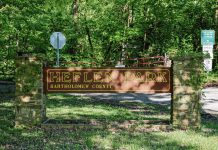The city has declared its vacant historic Pump House in downtown Columbus as an economic development project to attract interested buyers.
City officials have issued a request for proposals to find qualified buyers who would redevelop the building as a restaurant or retail space with a regional draw and restore its historic interior.
Built as the city water plant, the Pump House is located on the East Fork White River. It was the city’s senior center in the 1970s but has been vacant since 2011 when the new Mill Race Center opened.
The city rezoned the property in March 2014, limiting how developers could use the building. The building’s current zoning would allow only a restaurant, museum, liquor store or spa at the site.
In addition to limitations imposed by the zoning, an easement on the property means any new owner must have approval for any changes to the exterior of the building from Indiana Landmarks.
That’s all in effort to preserve the historic look and feel of the building, Mayor Kristen Brown said.
“The Pump House holds significant historic and sentimental value to our community,” Brown said. “We hope to have a private buyer who will restore and transform the Pump House into a spectacular destination along the riverfront that both community members and tourists will enjoy.”
Last year, the city estimated it would take a buyer interested in investing an estimated $2.5 million to transform the building into a tourist destination. The building needs a new roof and new windows, according to the city’s appraisal. It’s unknown whether the heating or air conditioning works, and the interior lighting is outdated and inefficient.
Potential developers will be vetted through a two-step process. They must first submit proof that they meet minimum criteria and have a specific business plan and the ability to invest in much-needed repairs to the property.
Based on bidders’ initial proposal due Feb. 27, a three-person team made up of city attorney Jeff Logston and two members of the Columbus Board of Public Works and Safety will then determine which developers will receive an invitation to make a bid on the property, Logston said.
Buyers must offer at least $285,000 — the average of two appraisals the city received — for the property and also prove that they:
- Have the financial ability to purchase the property and invest at least $2 million within two years to make necessary repairs.
- Would open a business with regional draw.
- Are experienced and have operational capabilities to carry out the concept they propose.
- Have put together a proposal that considers all socioeconomic groups and ages.
- Can improve the property with reasonable promptness.
The eventual buyer also would have to comply with the creation of an easement on the property to allow for the future extension of the People Trail and would have to work out licensing agreements with the Louisville & Indiana Railroad, whose main rail line passes through the property’s entrance.
The city hopes to have a recommended buyer to present to the city council, which approves all sales of city-owned property, on April 7.
City officials do know there are already some people who are interested in the property, Logston said. Five people or business representatives have requested information about the building, he said.
[sc:pullout-title pullout-title=”Pump House history” ][sc:pullout-text-begin]
1903: Opens as the city’s pumping station.
1976: Bartholomew County Senior Center moves in.
July 2011: City approves a five-year, renewable lease with chef Daniel Orr, who planned to open a restaurant/brew pub by fall 2012. Those plans are delayed in 2013 and never come to fruition.
March 2014: The Columbus City Council approves zoning changes to the property, limiting future uses for the building.
[sc:pullout-text-end]




